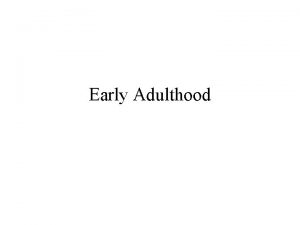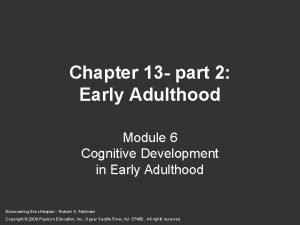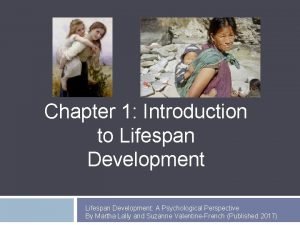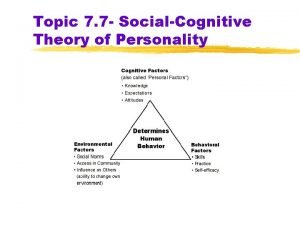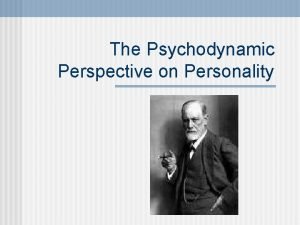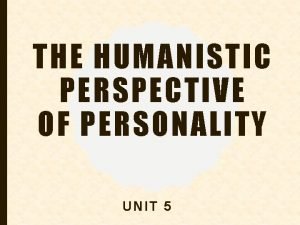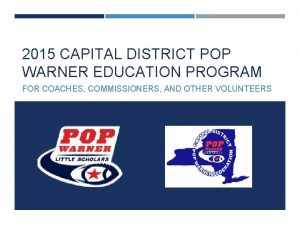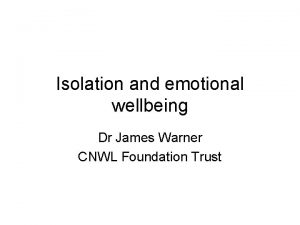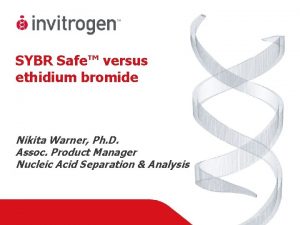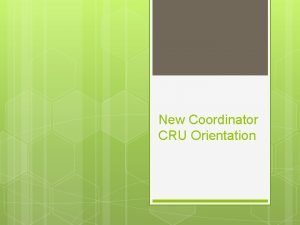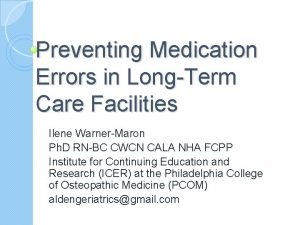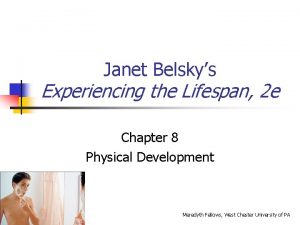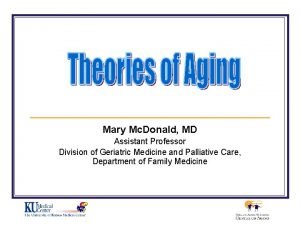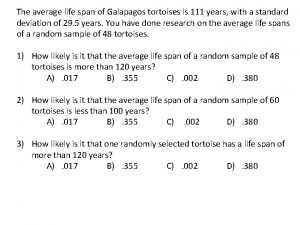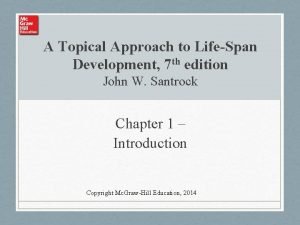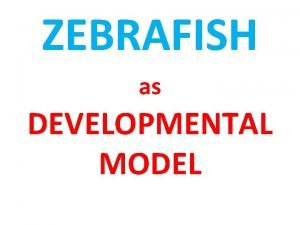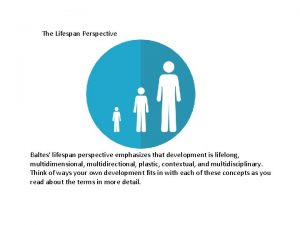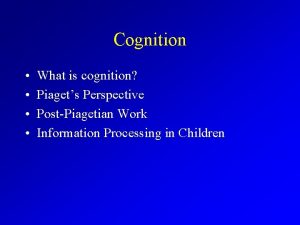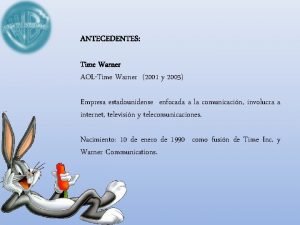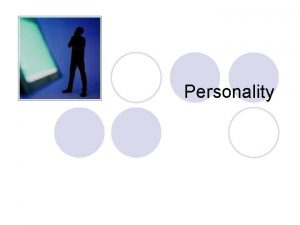Personality Cognition A Lifespan Perspective K Warner Schaie










































- Slides: 42

Personality & Cognition: A Lifespan Perspective K. Warner Schaie and Sherry L. Willis The Pennsylvania State University

Acknowledgments: This research is currently supported by a grant #AG 08055 from the National Institute on Aging (NIH). The long-term collaboration of members and staff of the Group Health Cooperative of Puget Sound is also gratefully acknowledged.

Overview: n n Design of the Seattle Longitudinal Study Methodological issues in the SLS Cognitive Abilities and Age Personality and Cognition n n Cognitive Styles Social Responsibility Age Differences on the NEO Personality Factors in the SLS

The Seattle Longitudinal Study (SLS) n n n Age Changes and Age Differences Antecedents of Individual Differences in Adult Dev Generational Differences Interventions to Slow Cognitive Aging Family Studies Early Detection of Dementia

Design of the Seattle Longitudinal Study

Major Focus of Study n n Dependent variables = Lifespan Development of Cognitive Abilities n e. g. Verbal, Spatial, Numeric, Reasoning Independent variables: n Environmental Influences n Cognitive Styles n Personality characteristics n Family Influences

Conceptual Model of SLS

Methodological Issues: n Distinguishing AGE, PERIOD, and COHORT effects Cross-Sectional data n Longitudinal data n Cohort effects n

The General Developmental Model b = f(Age, Period, Cohort) Age = Chronological Age Period = Time of Measurement Cohort = Year of Birth

Cross-Sectional Data : Age + Cohort Longitudinal Data: Age + Period

Sequential Methods of Data Collection


Basic Cognitive Ability Variables (Since 1956) n n n Verbal Meaning Space Reasoning Number Word Fluency

Latent Ability Constructs (Since 1984) n n n Inductive Reasoning Spatial Orientation Verbal Ability Numeric Ability Perceptual Speed

Markers of Latent Ability Constructs

Longitudinal Change in Cognitive Abilities

Cohort Differences in Cognitive Abilities

Cognitive Styles: n n n Motor-Cognitive Flexibility - Capacity to shift set in written responses Attitudinal Flexibility - Tolerance or preference for changing circumstances in daily life Psychomotor Speed - Speed and accuracy in simple written responses

Markers of Cognitive Styles

Cross-Sectional Age Differences

Cross-Sectional Age Differences

Cross-Sectional Age Differences

Longitudinal Changes in Cognitive Styles

Cohort Differences in Cognitive Styles

Correlations Between Cognitive Styles and Ability Variables Motor-Cognitive Flexibility Attitudinal Flexibility Psychomotor Speed Verbal Meaning . 54 *** . 40 *** . 68 *** Space . 47 *** . 26 *** . 39 *** Reasoning . 61 *** , 38 *** . 68 *** Number . 31 *** . 16 *** . 37 *** Word Fluency . 39 *** . 29 *** . 54 ***

Social Responsibility: Personal concerns and positive intents toward the resolution of social problems at the individual, community, national and international level. (Adapted from the California Personality Inventory)

Cross-Sectional Age Differences in Social Responsibility

Longitudinal Age Changes in Social Responsibility

Cohort Differences in Social Responsibility

The NEO Personality Inventory n Neuroticism - experience negative affect, susceptible to psychological distress n n Extraversion - sociable, assertive, talkative Openness - active imagination, aesthetic sensitivity, intellectual curiosity, independence of judgment n Agreeableness - sympathetic to others, ready to help, expects others will return help n Conscientiousness - purposeful, determined, fastidious, workaholic

NEO: Age/Cohort Differences

Correlations Between NEO and Ability Factors Neuroticism Extraversion Openness Agreeable Conscientious Memory . 01 . 14*** . 34*** . 03 . 04 Numeric -. 05 -. 10*** . 04 . 00 . 11*** Reason . 04 . 10*** . 30*** -. 10*** -. 04 Space . 06* . 05 . 19*** -. 16*** -. 03 Verbal -. 08** -. 01 . 36*** . 04 -. 10*** Speed . 03 . 15*** . 32*** -. 03 . 04

SLS Personality Factors n n n Affectothymia - Outgoing, wamhearted, participating Superego Strength - Conscientious, moralistic Threctia - -Shy, timid, restrained, threat sensitive Premsia - Tender-minded, sensitive, clinging Untroubled Adequacy -Self-assured, complacent Conservatism of Temperament - Respects traditional ideas, tolerant of traditional problems n n Group Dependency - A “joiner” and follower Low Self-Sentiment - Uncontrolled, lax, careless of social rules, follows own urge

Cross-Sectional Data: Negative Age and/or Cohort Trend:

Cross-Sectional Data: Positive Age and/or Cohort Trends

Longitudinal Age Changes: Stable or Negative

Longitudinal Age Changes: Positive

Cohort Differences in Personality Factors: U-Shape Trend

Cohort Differences in Personality Factors

Summary: n Development approaches to the study of personality involve: Cross-sectional, Longitudinal and Cohort perspectives n n n Cross-sectional - Age differences at one point in time Longitudinal - Age-related change for one or more cohorts Cohort - Cohort differences in age-related change

Summary: § Cognitive Styles: Longitudinal Age Change § § § Cognitive Styles: Cohort Trends - Positive increase Social Responsibility: Longitudinal Change § § Positive increase for males across age; stability for females SLS Personality Factors: Longitudinal Age Change § § Motor Cognitive- increase to midlife & stability thereafter Attitudinal - stability to midlife & decline thereafter Psychomotor speed - increase to midlife and decline thereafter Overall stability for most personality factors; decline for Affectothymia; increase for Group Dependency SLS Personality Factors: Differential Cohort Trends by Factor

The End
 Schaie's theory
Schaie's theory Acquisitive stage
Acquisitive stage Discontinuous development psychology
Discontinuous development psychology Silo perspective vs business process perspective
Silo perspective vs business process perspective How to draw stairs in 2 point perspective
How to draw stairs in 2 point perspective Free association
Free association Social cognitive theory of personality
Social cognitive theory of personality Projection defense mechanism
Projection defense mechanism Abraham maslow developed his hierarchy of needs
Abraham maslow developed his hierarchy of needs Humanistic perspective
Humanistic perspective Warner hospital and health services
Warner hospital and health services Capital district pop warner
Capital district pop warner Azure networking deep dive
Azure networking deep dive Dr james warner
Dr james warner Warner subotica
Warner subotica Warner publics and counterpublics
Warner publics and counterpublics Warner bros animation movies
Warner bros animation movies Warner blatzer
Warner blatzer Nikita warner
Nikita warner Fhea fitzgerald
Fhea fitzgerald Dr chris warner
Dr chris warner Gottwall books
Gottwall books Learning foundation and performing arts gilbert
Learning foundation and performing arts gilbert Isobel warner
Isobel warner Reuben warner associates
Reuben warner associates Daren warner
Daren warner Curly from hoot
Curly from hoot Carl warner
Carl warner Warner burke
Warner burke Cru warner robins
Cru warner robins Ilene warner
Ilene warner Lifespan development third edition
Lifespan development third edition Nudibranch scientific name
Nudibranch scientific name Lifespan of an eagle
Lifespan of an eagle Development takes place gradually
Development takes place gradually Experiencing the lifespan 4th edition
Experiencing the lifespan 4th edition Mary quiceno md
Mary quiceno md Galapagos turtle lifespan
Galapagos turtle lifespan A topical approach to lifespan development
A topical approach to lifespan development The developing person through the life span 9th edition
The developing person through the life span 9th edition Splendour beetle lifespan
Splendour beetle lifespan Ecology meaning
Ecology meaning Life cycle of zebrafish
Life cycle of zebrafish
